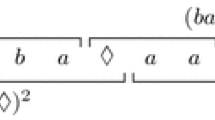Abstract
The combinatorics of squares in a word depends on how the equivalence of halves of the square is defined. We consider Abelian squares, parameterized squares and order-preserving squares. The word uv is an Abelian (parameterized, order-preserving) square if u and v are equivalent in the Abelian (parameterized, order-preserving) sense. The maximum number of ordinary squares is known to be asymptotically linear, but the exact bound is still investigated. We present several results on the maximum number of distinct squares for nonstandard subword equivalence relations. Let SQ Abel(n,k) and SQ′Abel(n,k) denote the maximum number of Abelian squares in a word of length n over an alphabet of size k, which are distinct as words and which are nonequivalent in the Abelian sense, respectively. We prove that SQ Abel(n,2) = Θ(n 2) and SQ′Abel(n,2) = Ω(n 1.5/logn). We also give linear bounds for parameterized and order-preserving squares for small alphabets: SQ param(n,2) = Θ(n) and SQ op(n,O(1)) = Θ(n). As a side result we construct infinite words over the smallest alphabet which avoid nontrivial order-preserving squares and nontrivial parameterized cubes (nontrivial parameterized squares cannot be avoided in an infinite word).
The authors thank anonymous referees for many helpful comments.
Access this chapter
Tax calculation will be finalised at checkout
Purchases are for personal use only
Preview
Unable to display preview. Download preview PDF.
Similar content being viewed by others
References
Baker, B.S.: Parameterized pattern matching: Algorithms and applications. Journal of Computer and System Sciences 52(1), 28–42 (1996)
Berstel, J., Karhumäki, J.: Combinatorics on words: A tutorial. Bulletin of the EATCS 79, 178–228 (2003)
Blanchet-Sadri, F., Jiao, Y., Machacek, J.M., Quigley, J., Zhang, X.: Squares in partial words. Theoretical Computer Science 530, 42–57 (2014)
Blanchet-Sadri, F., Merca, R., Scott, G.: Counting distinct squares in partial words. Acta Cybernetica 19(2), 465–477 (2009)
Crochemore, M., Ilie, L., Rytter, W.: Repetitions in strings: Algorithms and combinatorics. Theoretical Computer Science 410(50), 5227–5235 (2009)
Crochemore, M., et al.: Order-preserving incomplete suffix trees and order-preserving indexes. In: Kurland, O., Lewenstein, M., Porat, E. (eds.) SPIRE 2013. LNCS, vol. 8214, pp. 84–95. Springer, Heidelberg (2013)
Crochemore, M., Iliopoulos, C.S., Kociumaka, T., Kubica, M., Radoszewski, J., Rytter, W., Tyczyński, W., Waleń, T.: The maximum number of squares in a tree. In: Kärkkäinen, J., Stoye, J. (eds.) CPM 2012. LNCS, vol. 7354, pp. 27–40. Springer, Heidelberg (2012)
Crochemore, M., Iliopoulos, C.S., Kubica, M., Radoszewski, J., Rytter, W., Waleń, T.: Extracting powers and periods in a word from its runs structure. Theoretical Computer Science 521, 29–41 (2014)
Erdős, P.: An asymptotic inequality in the theory of numbers (in Russian). Vestnik Leningrad University: Mathematics 15, 41–49 (1960)
Erdős, P.: Some unsolved problems, Hungarian Academy of Sciences Mat. Kutató Intézet Közl. 6, 221–254 (1961)
Evdokimov, A.A.: Strongly asymmetric sequences generated by a finite number of symbols. Doklady Akademii Nauk SSSR 179(6), 1268–1271 (1968)
Fici, G.: Personal communication
Fici, G., Langiu, A., Lecroq, T., Lefebvre, A., Mignosi, F., Prieur-Gaston, É.: Abelian repetitions in Sturmian words. In: Béal, M.-P., Carton, O. (eds.) DLT 2013. LNCS, vol. 7907, pp. 227–238. Springer, Heidelberg (2013)
Fraenkel, A.S., Simpson, J.: How many squares can a string contain? Journal of Combinatorial Theory, Series A 82, 112–120 (1998)
Gusfield, D., Stoye, J.: Linear time algorithms for finding and representing all the tandem repeats in a string. Journal of Computer and System Sciences 69(4), 525–546 (2004)
Hardy, G., Wright, E., Heath-Brown, D., Silverman, J.: An Introduction to the Theory of Numbers. Oxford mathematics. OUP, Oxford (2008)
Huova, M., Karhumäki, J., Saarela, A.: Problems in between words and abelian words: k-abelian avoidability. Theor. Comput. Sci. 454, 172–177 (2012)
Ilie, L.: A simple proof that a word of length n has at most 2n distinct squares. Journal of Combinatorial Theory, Series A 112(1), 163–164 (2005)
Ilie, L.: A note on the number of squares in a word. Theoretical Computer Science 380(3), 373–376 (2007)
Keränen, V.: Abelian squares are avoidable on 4 letters. In: Kuich, W. (ed.) ICALP 1992. LNCS, vol. 623, pp. 41–52. Springer, Heidelberg (1992)
Muthukrishnan, S.: New results and open problems related to non-standard stringology. In: Galil, Z., Ukkonen, E. (eds.) CPM 1995. LNCS, vol. 937, pp. 298–317. Springer, Heidelberg (1995)
Muthukrishnan, S., Palem, K.: Non-standard stringology: Algorithms and complexity. In: Proceedings of the Twenty-sixth Annual ACM Symposium on Theory of Computing, STOC 1994, pp. 770–779. ACM, New York (1994)
Pleasants, P.A.: Non-repetitive sequences. Mathematical Proceedings of the Cambridge Philosophical Society 68, 267–274 (1970)
Thue, A.: Über unendliche Zeichenreihen. Norske Videnskabers Selskabs Skrifter Mat.-Nat. Kl. 7, 1–22 (1906)
Thue, A.: Über die gegenseitige Lage gleicher Teile gewisser Zeichenreihen. Norske Videnskabers Selskabs Skrifter Mat.-Nat. Kl. 10, 1–67 (1912)
Author information
Authors and Affiliations
Editor information
Editors and Affiliations
Rights and permissions
Copyright information
© 2014 Springer International Publishing Switzerland
About this paper
Cite this paper
Kociumaka, T., Radoszewski, J., Rytter, W., Waleń, T. (2014). Maximum Number of Distinct and Nonequivalent Nonstandard Squares in a Word. In: Shur, A.M., Volkov, M.V. (eds) Developments in Language Theory. DLT 2014. Lecture Notes in Computer Science, vol 8633. Springer, Cham. https://doi.org/10.1007/978-3-319-09698-8_19
Download citation
DOI: https://doi.org/10.1007/978-3-319-09698-8_19
Publisher Name: Springer, Cham
Print ISBN: 978-3-319-09697-1
Online ISBN: 978-3-319-09698-8
eBook Packages: Computer ScienceComputer Science (R0)




